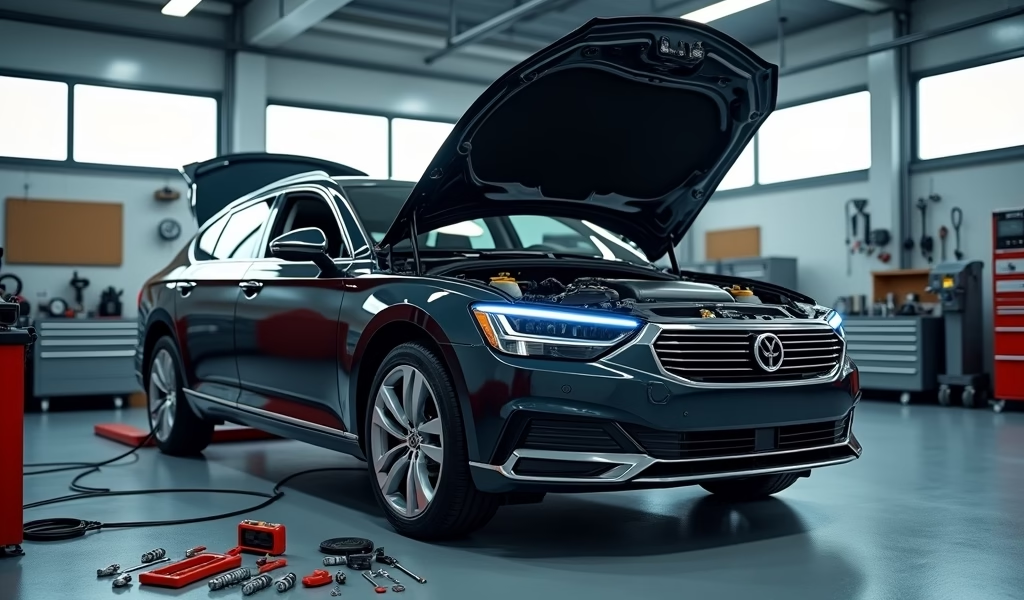Overview
This article provides practical solutions for seven common vehicle issues including battery problems, brake maintenance, engine overheating, tire care, oil changes, transmission troubles, and check engine light diagnostics. The guide emphasizes preventative maintenance as the key to avoiding costly repairs and breakdowns, offering specific warning signs, maintenance intervals, and troubleshooting tips for each system.
Table of Contents
- Introduction
- Battery Issues and Electrical Problems
- Brake System Maintenance
- Engine Overheating Solutions
- Tire Care and Maintenance
- Oil Changes and Fluid Maintenance
- Transmission Problem Solutions
- Check Engine Light Diagnostics
- Conclusion
- Frequently Asked Questions
Introduction
Your car is like that reliable friend who’s always ready for adventure—until suddenly, they’re not. We’ve all been there: that heart-sinking moment when your dashboard lights up like a Christmas tree or your engine makes a sound that definitely wasn’t in the owner’s manual.
As a mechanic with 15 years under my belt, I’ve seen it all. From the panic in a driver’s eyes when their car refuses to start, to the relief when they discover it’s just a loose gas cap triggering that ominous check engine light.
Car problems don’t play favorites. They happen to brand new vehicles and trusty old clunkers alike. But here’s the good news—understanding the basics can save you time, money, and those dreaded roadside headaches.
In this guide, we’ll walk through seven common car maintenance issues that every driver will likely face. I’ll share the same advice I give my own customers: straightforward solutions, preventative tips, and when it’s time to call in the professionals.
Think of this as your roadside companion for those moments when your four-wheeled friend decides to throw a mechanical tantrum. Let’s pop the hood and take a look, shall we?
Battery Issues and Electrical Problems
The battery is your car’s heart, pumping electrical life through its system. When it weakens, everything feels the impact.
Most batteries whisper before they scream. They’ll give you signs like sluggish engine cranking or headlights that dim when you’re idling. If your car groans when starting or dashboard lights flicker like a haunted house, your battery might be writing its will.
Testing a battery’s health isn’t rocket science. A simple multimeter can tell you if it’s delivering the proper voltage—about 12.6 volts when the engine’s off, and between 13.7-14.7 volts when running. Many auto parts stores offer free testing if you’re not confident doing it yourself.
When Jump-Starting Is Necessary
If you find yourself needing a jump, remember this sequence: positive to dead battery, positive to good battery, negative to good battery, then negative to unpainted metal on the dead car’s frame (not the battery terminal). This reduces spark risk near potentially explosive hydrogen gas.
Most batteries live about 3-5 years before they start contemplating retirement. If yours is in this age bracket and showing symptoms, don’t wait for it to leave you stranded at the worst possible moment—usually in the rain, at night, when you’re already late.
Beyond battery woes, electrical gremlins might include alternator issues (your battery drains while driving), starter problems (clicking noises but no start), or computer glitches. These typically require diagnostic tools, but knowing the symptoms helps you communicate with your mechanic without sounding like you’re speaking a foreign language.
According to the American Automobile Association, battery failures are among the top reasons for roadside assistance calls, with extreme temperatures being major culprits in reducing battery life.

Brake System Maintenance
Your brakes aren’t just another car component—they’re your primary lifeline when that deer decides to play chicken on a dark country road.
When brakes talk, smart drivers listen. That high-pitched squeal? It’s not your car singing opera—it’s your brake pads’ way of saying “I’m getting thin, replace me before things get expensive.” That grinding sound? We’re already in expensive territory.
Brake warning signs are usually unmistakable:
- Squealing or grinding noises (especially when braking)
- Vibrating or pulsating brake pedal (like a mini earthquake under your foot)
- Vehicle pulling to one side when braking (as if it’s being tugged by an invisible rope)
- Soft or spongy pedal feel (like stepping on a marshmallow)
- Longer stopping distances (when you start planning your stops like a chess game)
Brake pads typically need replacement every 30,000-70,000 miles, depending on your driving style and the pad quality. If you drive like you’re auditioning for Fast & Furious, expect to replace them more frequently than your grandma who only drives to church on Sundays.
Don’t forget brake fluid—this hydraulic marvel should be checked regularly and replaced every 2-3 years. Like that bottle of ranch dressing in your fridge, it has an expiration date. Over time, it absorbs moisture, reducing its effectiveness and potentially damaging internal components.
While some DIY warriors tackle brake work successfully, this is one area where professional help often makes sense. As one of my customers wisely put it: “I’ll save money on many things, but not on what stops me from hitting a tree.”
Engine Overheating Solutions
An overheating engine is like a toddler having a meltdown in a grocery store—ignore it, and things will get worse, fast.
Your engine’s cooling system is a marvel of engineering, circulating coolant to maintain optimal operating temperature. When this delicate balance fails, temperature gauges climb, steam appears, and if ignored, expensive damage follows.
Common culprits behind overheating include:
- Low coolant levels or leaks (check for puddles under your parked car)
- Faulty water pump (the heart of your cooling system)
- Blocked radiator (like trying to breathe through a straw)
- Malfunctioning thermostat (stuck closed, it’s like wearing a winter coat in summer)
- Failed cooling fan (critical for stop-and-go traffic)
Preventative maintenance is your best defense against engine overheating causes. Check coolant levels regularly when the engine is cool—never remove a radiator cap on a hot engine unless you enjoy emergency room visits. Coolant should be replaced according to your vehicle’s maintenance schedule, typically every 2-5 years.
If you find yourself with a temperature gauge creeping into the danger zone, safely pull over, turn off the engine, and let it cool down naturally. Running an overheating engine is like continuing to run on a broken ankle—you’re turning a manageable problem into surgery.
Consider radiator flushes every 40,000-60,000 miles to remove deposits that reduce cooling efficiency. Think of it as a spa treatment for your cooling system—clearing out the gunk for better flow.
According to research from the National Highway Traffic Safety Administration, proper vehicle maintenance significantly reduces the risk of breakdowns and accidents, with cooling system failures being a preventable cause of roadside emergencies.
Tire Care and Maintenance
Your tires are the only parts of your car that actually touch the road, yet they’re often the most neglected. It’s like caring for every part of your body except your feet—eventually, you’re going nowhere.
Proper tire pressure isn’t just about avoiding flats—it affects handling, braking, fuel economy, and tire lifespan. Underinflated tires flex excessively, building heat that can lead to blowouts. Overinflated tires ride roughly and wear unevenly in the center.
Check your tire pressure monthly when the tires are cold. The correct pressure is usually listed on a sticker in your driver’s door jamb or in your owner’s manual—not on the tire sidewall (that’s the maximum pressure, not the recommended one).
Tire rotation ensures even wear patterns and extended life. Most vehicles benefit from rotation every 5,000-8,000 miles. It’s like rotating your mattress—spread the wear for longer use.
Uneven tire wear tells a story about your vehicle’s health. Center wear screams overinflation, edge wear whispers underinflation, and one-sided wear suggests alignment issues. Reading these patterns is like a mechanic’s version of palm reading—except it actually predicts your automotive future.
The penny test remains a reliable way to check tread depth. Insert a penny with Lincoln’s head upside down into your tire tread. If you can see the top of his head, start shopping for new tires. It’s a simple test that costs exactly one cent.
Don’t forget seasonal considerations. All-season tires are jack-of-all-trades but masters of none. If you live where serious winter happens, dedicated winter tires provide dramatically better traction in snow and ice—like trading dress shoes for snow boots when the blizzard hits.

Oil Changes and Fluid Maintenance
Engine oil is the lifeblood of your vehicle, and skipping oil changes is like refusing to drink water—eventually, things seize up.
Modern engines are precision machines with tolerances measured in thousandths of an inch. Clean oil lubricates, cools, cleans, and protects these components. As oil ages, it becomes less effective at all four jobs.
The old “every 3,000 miles” rule is largely outdated for modern vehicles and synthetic oils. Today’s cars typically need oil changes every 5,000-7,500 miles for conventional oil and 7,500-15,000 for full synthetic. Always defer to your owner’s manual—the engineers who built your engine know what it needs better than that quick-lube place with the coupon.
Checking your oil is a simple task that can prevent complex problems:
- Park on level ground with the engine off and cool
- Remove the dipstick, wipe it clean, reinsert fully
- Remove again and check the level—it should be between the min/max marks
- Inspect the color—it should be amber to light brown, not black or milky
Oil isn’t your car’s only vital fluid. Your vehicle relies on a cocktail of specialized liquids to function properly. Transmission fluid, brake fluid, power steering fluid, and coolant each have their own maintenance schedules and specific indicators when service is needed.
For the DIY-inclined, an oil change is basic car maintenance you can master. You’ll need oil, a filter, a drain pan, wrenches, and proper disposal options for the used oil. Auto parts stores typically accept used oil for recycling.
Fluid leaks can often be identified by color: engine oil (amber to black), transmission fluid (red to brown), coolant (green, orange, or pink), brake fluid (clear to amber), and power steering fluid (typically red or pink). A single drop under your parked car isn’t always cause for panic, but puddles or persistent drips should be addressed promptly.
Transmission Problem Solutions
Your transmission is the unsung hero of your drivetrain—working tirelessly to harness engine power and deliver it to your wheels in usable form. When it falters, the driving experience deteriorates quickly.
Modern transmissions are marvels of engineering, whether automatic, manual, CVT, or dual-clutch. Each type has its own quirks, but they all share common warning signs when troubles brew.
Watch for these transmission red flags:
- Delayed engagement when shifting into drive or reverse (that awkward pause before movement)
- Rough shifts or unexpected shifting behavior (like being on a mechanical bucking bronco)
- Slipping sensation (engine revs but vehicle doesn’t accelerate proportionally)
- Strange noises during shifts (clunks, whines, or buzzes)
- Warning lights illuminated on your dashboard (the car’s way of waving frantically for attention)
Unlike engine oil, transmission fluid in many modern vehicles is designed to last the vehicle’s lifetime without changes. However, “lifetime” often means the warranty period, not forever. Checking the fluid level and condition remains important in vehicles with dipsticks. The fluid should be red, not brown, and shouldn’t smell burnt—that’s the scent of transmission components cooking.
Many newer vehicles have sealed transmissions requiring professional service to check fluid levels. This design reduces the chance of contamination but eliminates the DIY inspection option.
Common transmission problems include solenoid issues (the electrical valves that control fluid flow), worn clutches, torque converter problems, and electronic control malfunctions. Some issues, like external fluid leaks or linkage adjustments, might be DIY-friendly.
However, internal transmission repair typically falls into “professional territory.” These complex components require specialized tools, expertise, and sometimes computer programming. The good news? Many transmission problems can be prevented with proper maintenance and gentle driving habits.
Preventative care includes avoiding aggressive driving habits that strain the transmission, not shifting into reverse while still rolling forward (a common parking lot sin), warming up briefly in extremely cold weather, and using the parking brake on inclines rather than relying solely on the transmission’s parking pawl.
Check Engine Light Diagnostics
The check engine light—that amber harbinger of potential problems that can strike fear into any driver’s heart. It’s like getting a text that just says “we need to talk” without any context.
First, understand that not all check engine lights are created equal. A steady light typically indicates a non-emergency issue that should be checked soon. A flashing light is your car screaming for immediate attention—it signals a severe problem that could cause damage if you keep driving.
Modern vehicles speak a standardized diagnostic language called OBD-II (On-Board Diagnostics, version 2). Decoding this language once required expensive dealer equipment, but today, affordable code readers connect to your smartphone via Bluetooth, putting diagnostic information in your hands.
Common causes for that illuminated dashboard icon include:
- Loose or faulty gas cap (yes, really—the simplest fix of all)
- Oxygen sensor failures (affecting fuel efficiency and emissions)
- Catalytic converter issues (expensive but critical for emissions control)
- Spark plug or ignition coil problems (causing misfires and rough running)
- Mass airflow sensor malfunctions (confusing your engine’s computer about how much air is entering)
Knowing when to worry versus when to wait requires context. A check engine light accompanied by other symptoms—rough running, smoke, strange noises, loss of power—warrants immediate attention. A light with no other symptoms can usually wait a short while but should still be diagnosed soon.
For complex issues, professional diagnostics may be necessary. A code reader tells you where to start looking, but a skilled technician brings experience and deeper diagnostic tools to interpret what’s actually happening. It’s the difference between WebMD telling you that your headache could be anything from stress to a brain tumor, versus a doctor’s trained diagnosis.
Remember that the check engine light is your vehicle’s way of communicating. Ignoring it is like ignoring a smoke detector—you might be fine for a while, but you’re gambling with potentially expensive consequences.
Conclusion
Your vehicle is a complex partnership of mechanical and electronic systems working in harmony to safely transport you through life’s journeys. Understanding these seven essential problem areas—battery issues, brake maintenance, overheating solutions, tire care, fluid maintenance, transmission health, and check engine diagnostics—puts you in the driver’s seat of your car’s wellbeing.
Small investments in preventative maintenance yield enormous returns in reliability and longevity. A $20 thermostat replacement prevents a $2,000 engine rebuild. Fresh brake pads at $150 avoid a $500 rotor replacement and potential accident costs. In the automotive world, an ounce of prevention truly is worth a pound of roadside assistance.
Listen to your vehicle. Those little noises, vibrations, and warning lights are its way of communicating needs before they become emergencies. Think of maintenance not as an expense, but as an investment in trouble-free transportation.
Whether you’re a DIY enthusiast or prefer leaving it to the professionals, understanding the basics helps you make informed decisions. You don’t need to know how to rebuild a transmission to recognize when it needs attention.
Remember that regular service according to your manufacturer’s recommendations isn’t just a suggestion—it’s the roadmap to keeping your vehicle running smoothly for years to come. Your owner’s manual is like a crystal ball, predicting exactly what your car will need and when.
Drive safely, maintain regularly, and enjoy the peace of mind that comes from knowing you’ve done everything possible to prevent those roadside moments that always seem to happen when it’s raining, you’re late, and your phone battery is at 2%.
Frequently Asked Questions
How often should I really change my oil?
Follow your owner’s manual recommendations, which typically range from 5,000-7,500 miles for conventional oil and 7,500-15,000 for full synthetic. Modern vehicles with electronic oil life monitors take the guesswork out by calculating when changes are needed based on your actual driving habits.
Why does my steering wheel shake when I brake?
Steering wheel vibration during braking usually indicates warped brake rotors. This happens when rotors develop uneven surfaces, causing pulsation that you feel through the steering wheel when the brake pads grip them.
What should I do if my car overheats while driving?
Safely pull over, turn off the engine, and let it cool down completely before checking coolant levels or opening the radiator cap. Never remove a radiator cap on a hot engine as the pressurized coolant can cause severe burns.
Is it dangerous to drive with the check engine light on?
A steady check engine light indicates a problem that should be checked soon but doesn’t require immediate action. A flashing check engine light signals a severe problem that could damage your catalytic converter or engine if you continue driving—pull over when safe and seek assistance.
How do I know when I need new tires?
Use the penny test by inserting a penny with Lincoln’s head upside down into your tire tread; if you can see the top of his head, your tires are worn below the safe threshold of 2/32″. Also watch for uneven wear, sidewall damage, bulges, or tires older than six years regardless of tread depth.


Pingback: Best websites for common car problems?! - knowsyourcar.com